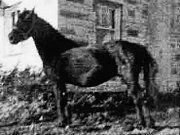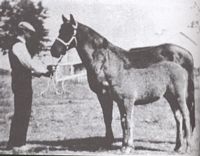|
|
|
Many thanks to Gladys M Beattie for permission to use photos from her book, "The Canadian Horse: A Pictorial History". We highly recommend this book to anyone interested in the breed. It is available thru CHARMD http://www.canadianhorsebreeders.com
|
 |
MARE LINES
The most significant fact, in terms of horse breeding, that the science of genetics has recently given us, has been a new understanding of inheritance. Geneticists have determined that certain genes are carried on the female X-chromosome, including genes for a large heart, and intelligence.
The second phenomenon to be verified by science is the Maternal Grandsire Effect. This phenomenon has been observed and intuitively recognized by serious horsemen for a very long time. Even though they did not know why some outstanding males did not immediately reproduce their greatness in the next generation, but instead, produced daughters who were outstanding dams, they knew that it happened. By following their observations and intuitions, these breeders consistently improved their chances of producing better foals. What accounts for this phenomenon?
As Mattson explains: “Every horse has 2 chromosomes that determine gender. A mare has two X-chromosomes, therefore is female. A stallion (XY) has one x-chromosome and one Y-chromosome, therefore is male. When a foal is conceived, if a sperm with the Y-chromosome fertilizes the egg, the foal will be male (XY) because it will then have an "X" from the dam and a "Y" from the sire. If the sperm fertilizing the egg carries the stallion's X-chromosome, the resulting foal will be female (XX). A mare, therefore always contributes one of her X-chromosomes to her foals, both male and female ... but a stallion can only give his "X" to his daughters, which ALWAYS receive his X-chromosome. His sons NEVER receive it, because he has given them (obviously) his Y-chromosome. However, his sons DO receive an X-chromosome ... from their DAM. They say that the X-chromosome contains more genetic material than the Y, and maybe that stands to reason if you consider that the female sperm are larger than the males. In fact, experts now say that by the time you follow the tail-male (sire line) lineage for 50 years, there will be no resemblance whatsoever to the original line!”
Once we understand that certain superior qualities can only be transmitted from a mare to her progeny, the basic pieces of the Maternal Grandsire puzzle fall into place. Breeders trying to breed each generation better than the last are now realizing that this newly verified information can hold the key to success.
While more research is needed to identify all the great matriarchs of the Canadian breed, there are a few mares that stand out in excellence of progeny. One of these mares is Brunette 3eme ( third).
|
|
Brunette 3eme (#3583) was foaled July 4, 1954, and bred by Lionel Bourque of St. Hyacinthe, Quebec, She was later owned by long-time breeders Ernest, then Maurice Sylvestre, and then by M Phillipe Bergeron. Brunette 3eme came from very old, mainly privately-bred foundation stock, and carried little government breeding in her pedigree. Her dam, Brunette #3290 was a granddaughter in direct female line of the foundation mare Datura, foaled in 1909. Brunette 3eme’s sire, Albert de St. Isadore, was the sire of Pitro, and of La Gorgendiere Reine (dam of two of the “eight” line sires.)
Brunette 3eme’s first foal, born in 1958, was the champion performance horse and line sire, Brio de La Victoire. She later produced the Bienvenue prefix horses: Finette (dam of Rieucafol Baron Eno) by La Gorgendiere Jovial; Lou Heros and Lou L’Houblon by Lou; and Brillant, Celina, Eric, Fanfaron, and Mona by Prince Royal. She is one of the most notable and influential mares found in Canadian Horse pedigrees today. To read more about Brunette 3eme’s influence on the breed, visit Descoteaux Farm. mare page.
|
 |
 |
 |
 |
A no less influential mare in the Canadian breed was Kate de Cap Rouge #1949, daughter of Daniel de Cap Rouge x Helene. Kate was foaled in 1923 and was both a half-sister and granddaughter to Albert de Cap Rouge. Kate produced three excellent daughters whose lines survive prominently today through their line-sire descendants. Sarcelle de Cap Rouge (by Keller) foaled 1931, won the foal class that same year at the Royal Winter Fair in Ontario. Sarcelle was the dam of notable line sire Thomas de Viger. Tassette de Cap Rouge foaled 1932, (also by Keller) was successfully shown, and produced Beauport de Cap Rouge, sire of La Gorgendiere Royal and Prince Black. Kate's third daughter, Zola by noted broodmare sire Tom, produced St. Anne Hisola, dam of St. Anne Marquis de Becancour.
|
|
|